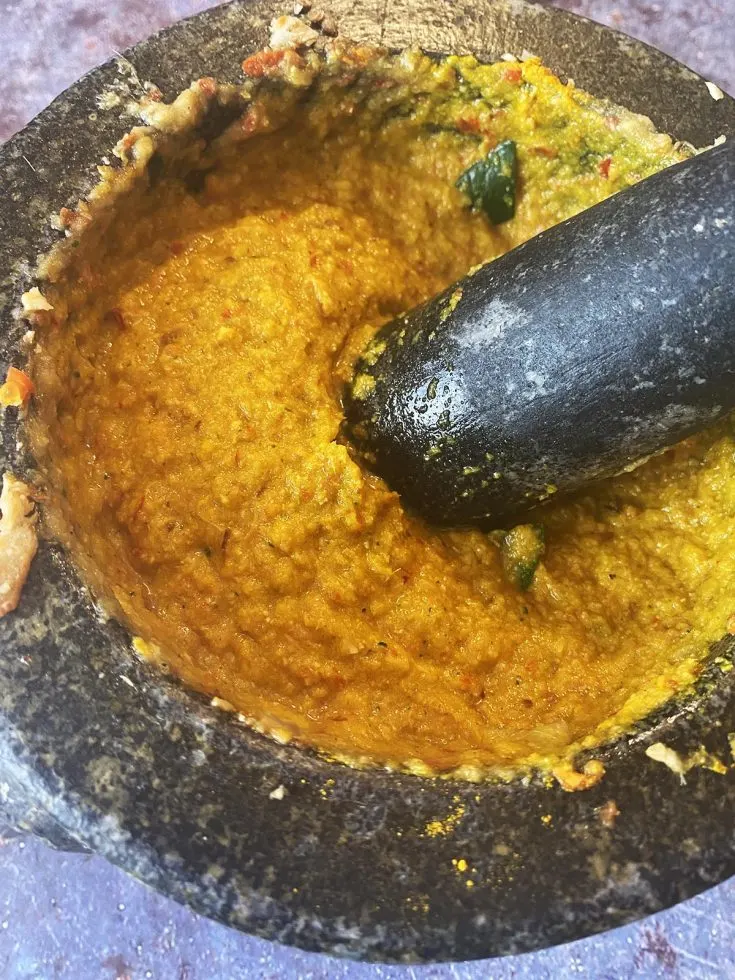This easy and authentic Thai yellow curry paste gets amazing results.
Thai yellow curry paste, like the other pastes, can be used in many different dishes. The yellow colouring comes from the turmeric. I usually use fresh turmeric because it releases more moisture and I prefer the flavour. You could use dried ground turmeric if you like. A word of warning: if using fresh turmeric, it colours everything it comes in contact with!

Thai yellow curry paste ready to make one awesome curry!
About Thai yellow curry paste…
This is the mildest of the curry pastes. It is really a milder version of Thai red curry paste but with added turmeric, which gives Thai yellow curries an eye-catching yellow colour.
Making Thai yellow curry paste or any Thai curry paste for that matter can be a bit time consuming if you do it the traditional way in a pestle and mortar. This isn’t done at most restaurants anymore. Using a blender or food processor will still get you a curry paste that is right up there with the best.
Why pound the curry paste?
Some chefs still insist on pounding their pastes in a pestle and mortar. Again, this is not essential for excellent flavour. Their argument is that by pounding the ingredients, you get a lot more flavour than simply blending them.
Why not try both methods? Then you can decide for yourself whether pounding is best. Personally, I think their is a small flavour advantage to pounding but I normally just blend the ingredients to save time.
You can cheat though as many chefs of course do. Put all the ingredients in a food processor and blend to a paste. Done!
Pounding vs. blending the pastes…
To pound a Thai curry paste, you will need to put aside 40 to 60 minutes to do so. You can blend them in a fraction of the time which is why that is now the method I prefer.
Can Thai yellow curry paste be frozen?
You bet! In fact curry pastes freeze really well. When you prepare you curry pastes, you might like to upscale the recipes. Then you’ll have some for dinner and other batches ready for future Thai feasts.
Curry pastes can also be stored in the fridge for about a week, in an air-tight container.
Why does this curry paste recipe work?
This is the real deal! My wife Caroline and I travelled all over Thailand. We got to meet some excellent chefs and home cooks while researching recipes for my cookbook ‘The Curry Guy Thai’.
This is how pastes are made in Thailand. Most home cooks no longer pound their pastes if they make them at all.
There are plenty of excellent quality curry pastes at the markets that are prepared and ready for cooking. This, unfortunately isn’t the case in the west so if you want to try Thai food as it should be, take some time to prepare your own homemade pastes.
Special ingredients…
There are a few ingredients you might not be familiar with.
- Galangal: Like ginger, galangal is rhizome and looks similar to ginger but they have very different flavours. Galangal has a citrusy flavour and is milder than ginger. It is also woodier in texture so it needs to be pounded or finely chopped. As the flavours are different, you really should not substitute ginger for galangal but if you must, do it. Your Thai yellow curry paste will still be delicious. Galangal is available at Asian shops, some supermarkets and online.
- Lime leaves: You will find makrut (or kaffir) lime leaves at many supermarkets, online and at Asian shops. They offer a delicious and subtle flavour of lime that’s not to be missed! The stems are woody, so cut them out before using in a paste or curry.
- Shrimp paste: This is a strong flavoured paste that tastes terrible on it’s own but delicious when cooked or prepared with other ingredients. As it is quite potent, it is used in small quantities in Thai cooking.
- Turmeric: I use ground turmeric for ease. In my own taste tests, I have not seen much benefit in using the fresh stuff but fresh does add a more yellow colour. It is messy to use and stains though so be careful.
Useful kitchen equipment…
You probably already have everything you need to start making this Thai yellow curry paste. Here are a few of the things I use in my kitchen regularly…
- A good chef’s knife: There is a lot of slicing and chopping in the preparation of Thai dishes. One excellent quality knife is much better than a selection of useless knives. So find one you love using and that’s all you’ll need.
- A heavy pestle and mortar: If you want to prepare your Thai yellow curry paste the traditional way, invest in a good pestle and mortar. Every paste needs to be made in a mortar at least once.
- A good blender or food processor: This is how you will probably be preparing your Thai pastes most often. So having a good quality blender or food processor will come in handy.
That this Thai yellow curry paste be adjusted to taste?
Yes! All Thai curry pastes can be adjusted so that they have the flavour that is perfect for you. You can add more or add fewer of any of the ingredients in the following recipe until you have the perfect blend of sweet, savoury, spicy and sour flavours.
Other ways to use this Thai yellow curry paste…
There are no rules! You can use this paste in any of the Thai curries and other Thai dishes on this blog. Simply follow the recipe and use it instead of one of the other pastes for a delicious and perhaps unique Thai food experience.
Thai curry pastes make amazing homemade gifts!
If you love to cook as much as I do and know someone who isn’t as keen but still loves Thai food, giving them a homemade Thai curry paste or two will make cooking for them more delicious and more fun.
Do you know anyone who might like this gift? I sure do.
Anyone can prepare a Thai curry paste!
The great thing is, anyone, professional chef or novice can whip up a delicious Thai curry paste.
What’s more, once the curry paste is prepared, the rest of the job of cooking a delicious curry is even easier. You really can get professional, restaurant quality results at home. In fact, your homemade Thai curries will be better than those at most restaurants because they purchase big tubs of paste instead of making their own.
So if you love Thai food, there’s no excuse. Make this recipe and try some of my other traditional pastes and you will be very happy your did.
If you like this Thai yellow curry paste, you really should try some of these recipes too…
Thai yellow curry
Thai green curry paste
Massaman curry paste
Panang curry paste
Thai red curry paste
Thai Yellow Curry Paste

Ingredients
- 11⁄2 tsp coriander seeds
- 11⁄2 tsp cardamom seeds
- 1⁄2 tsp green cardamom seeds (optional)
- 11⁄2 tsp white pepper
- 12 dried red bird’s eye chillies, soaked in water for
- 30 minutes and then cut into small pieces
- 12 garlic cloves
- 1 thumb-sized piece of galangal, thinly sliced
- 1 thumb-sized piece of fresh turmeric, peeled and
- thinly sliced, or 1–11⁄2 tsp ground turmeric
- 3 lime leaves, stalks removed and finely chopped 3 medium shallots, halved
- 10 thick coriander stalks (about 1 generous tbsp) 2 tbsp sliced lemongrass (1⁄2 lemongrass stalk)
- 1 tsp shrimp paste
Instructions
- Heat a pan over a medium–high heat and toast the whole spices until warm to the touch and fragrant but not yet smoking. Transfer to a pestle and mortar and pound to a fine powder
- Add the white pepper and pound, then add the dried red chillies and start pounding into a paste. Continue with the garlic, adding each new ingredient, up to and including the lemongrass, until you have a smooth, buttery curry paste. This will take between 40 and 60 minutes. You can also cheat and just blend it.
- Once you have a fragrant and smooth paste, add the shrimp paste and continue pounding to incorporate. Check for seasoning. The paste will keep in the fridge for about 2 weeks and freezes very well for up to 2 months.

Maarten
Wednesday 20th of October 2021
Hi Dan, the ingredients currently says 11⁄2 tsp cardamom seeds I think that should be cumin seeds, right?
Dan Toombs
Wednesday 20th of October 2021
Yes, you are right. That should be cumin seeds. Thanks for noticing! Dan